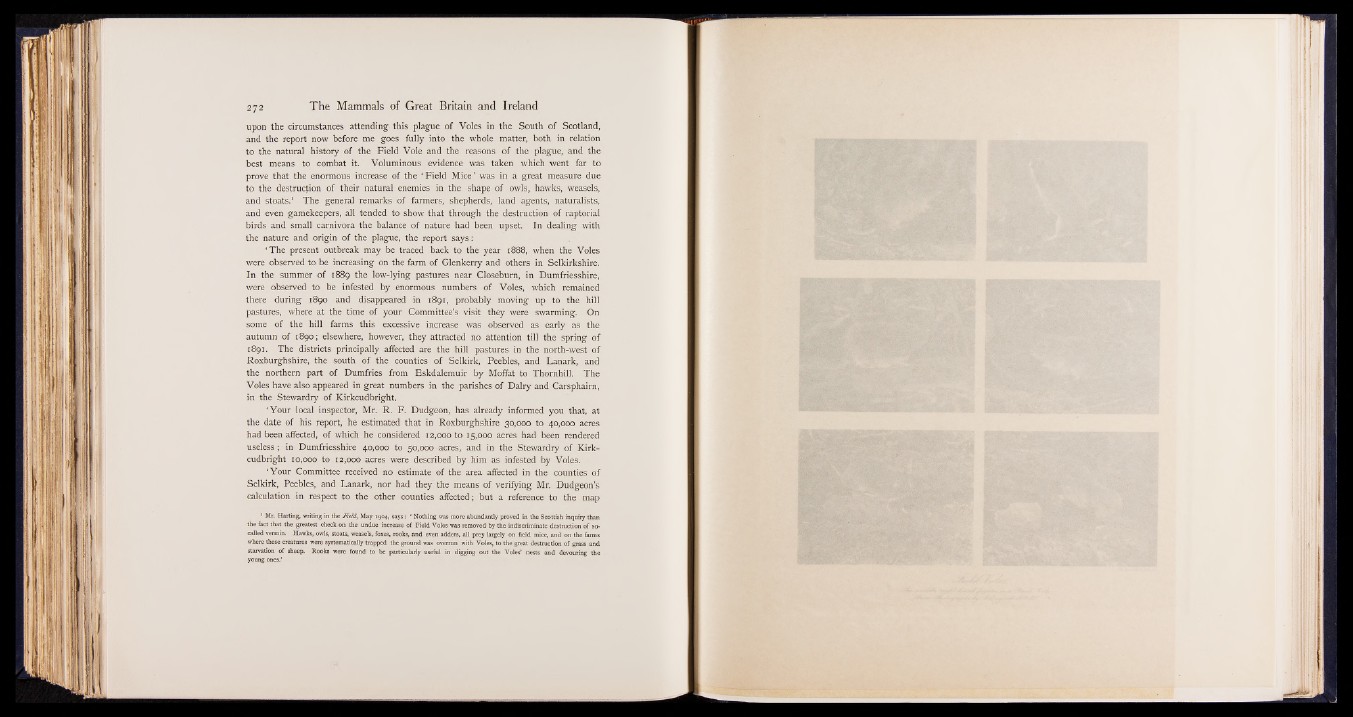
upon the circumstances attending this plague of Voles in the South of Scotland,
and the report now before me goes fully into the whole matter, both in relation
to the natural history of the Field Vole and the reasons of _the plague, and the
best means to combat it. Voluminous evidence was taken which went far to
prove that the enormous increase of the ‘ Field Mice ’ was in a great measure due
to the destruction of their natural enemies in the shape of owls, hawks, weasels,
and stoats.1 The general remarks of farmers, shepherds, land agents, naturalists,
and even gamekeepers, all tended to show that through the destruction of raptorial
birds and small carnivora the balance of nature had been upset. In dealing with
the nature and origin of the plague, the report Says:
‘ The present outbreak may be traced back to the year 1888, when the Voles
were observed to be increasing on the farm of Glenkerry and others in Selkirkshire.
In the summer of 1889 the low-lying pastures near Closeburn, in Dumfriesshire,
were observed to be infested by enormous numbers of Voles, which remained
there during 1890 and disappeared in 1891, probably moving up to. the hill
pastures, where at the time of your Committee’s visit they were swarming. On
some of the hill farms this excessive increase was observed as early as the
autumn of 1890; elsewhere, however, they attracted no attention till the spring of
1891. The districts principally affected are the hill pastures in the north-west of
Roxburghshire, the south of the counties of Selkirk, Peebles, and Lanark, and
the northern part of Dumfries from Eskdalemuir by Moffat to Thornhill. The
Voles have also appeared in great numbers in the parishes of Dairy and Carsphairn,
in the Stewardry of Kirkcudbright.
‘ Your local inspector, Mr. R. F. Dudgeon, has already informed you that, at
the date of his report, he estimated that in Roxburghshire 30,000 to 40,000 acres
had been affected, of which he considered 12,000 to 15,000 acres had been rendered
useless; in Dumfriesshire 40,000 to 50,000 acres, and in the Stewardry of Kirkcudbright
10,000 to 12,000 acres were described by him as infested by Voles.
‘ Your Committee received no estimate of the area affected in the counties of
Selkirk, Peebles, and Lanark, nor had they the means of verifying Mr. Dudgeon’s
calculation in respect to the other counties affected; but a reference to the map
1 Mr. Harting, writing in the F ield , May 1904, says : 1 Nothing was more abundantly proved in the Scottish inquiry than
the fact that the greatest check on the undue increase of Field Voles was removed by the indiscriminate destruction of so-
called vermin. Hawks, owls, stoats, weasels, foxes, rooks, and even adders, all prey largely on field mice, and on the farms
where these creatures were systematically trapped the ground was overrun with Voles, to the great destruction of grass and
starvation of sheep. Rooks were found to be particularly useful in digging out the Voles’ nests and devouring the
young ones.’